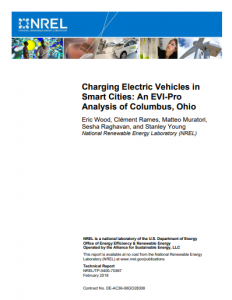Full Title: Charging Electric Vehicles in Smart Cities: An EVI-Pro Analysis of Columbus, Ohio
Author(s): Eric Wood, Clément Rames, Matteo Muratori, Sesha Raghavan, and Stanley Young
Publisher(s): National Renewable Energy Laboratory (NREL)
Publication Date: February 1, 2018
Full Text: Download Resource
Description (excerpt):
In June 2016, the City of Columbus, Ohio, won the U.S. Department of Transportation Smart
City Challenge, laying the foundation to become a model for future sustainable transportation in
the United States and abroad. With the support of the U.S. Department of Energy’s Vehicle
Technologies Office, the National Renewable Energy Laboratory worked with the City of
Columbus, The Ohio State University, Clean Fuels Ohio, the Mid-Ohio Regional Planning
Commission, and American Electric Power to develop a plan for the expansion of the region’s
network of charging stations to support increased adoption of plug-in electric vehicles (PEVs) in
the local market. Potential sites include multi-unit dwellings to support PEV ownership in urban
environments, workplaces to maximize electric vehicle miles, and strategic locations along
highway corridors to enable regional travel.
The National Renewable Energy Laboratory’s Electric Vehicle Infrastructure Projection (EVIPro)
model was used to generate scenarios of regional charging infrastructure to support
consumer PEV adoption based on travel patterns provided by INRIX (a commercial
mapping/traffic company) that are used to characterize regional travel in the Columbus area and
anticipate future demand for PEV charging. Moreover, charging loads considering different
levels of residential and public charging are reported to better inform the impact of PEV
adoption on the electric load. This report provides guidance on PEV charging infrastructure to
stakeholders in the Columbus area to reduce range anxiety as a barrier to PEV sales and ensure
the effective use of private/public investments in PEV charging infrastructure.
Results indicate that approximately 400 Level 2 plugs at multi-unit dwellings and 350 Level 2
plugs at non-residential locations are required to support Columbus’ primary PEV goal of 5,300
PEVs on the road by the end of 2019. This analysis finds that while consumer demand for fast
charging is expected to remain low (due to modest anticipated adoption of short-range battery
electric vehicles), a minimum level of fast charging coverage across the city is required to ease
consumer range anxiety concerns by providing a safety net for unexpected charging events.
Sensitivity analyses around some key assumptions have also been performed; of these, consumer
preference for PHEV versus BEV and for their electric driving range, ambient conditions, and
availability of residential charging at multi-unit dwellings were identified as key determinants of
the non-residential PEV charging infrastructure required to support PEV adoption. The results
discussed in this report can be leveraged by similar U.S. cities as part of a strategy to accelerate
PEV adoption in the light-duty vehicle market.
